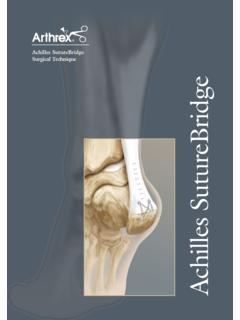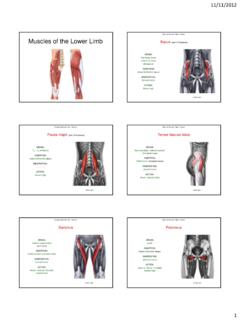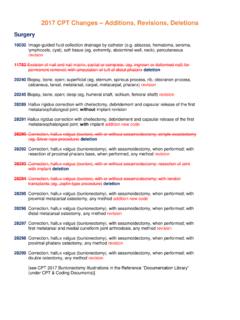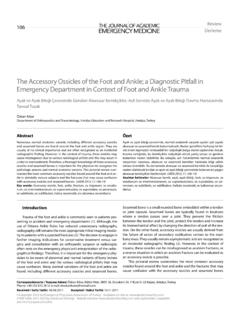Transcription of Common Foot Pathologies - Dynamic Orthotics
1 Common foot Pathologies Chondromalacia Patella (patellofemoral pain syndrome). Chondromalacia Patella (patellofemoral pain syndrome). What is it? Chondromalacia (of Greek origin meaning softening of the cartilage ) is a degenerative cartilage condition wherein the cartilage on the back of the patella (knee cap) is irritated and painful because it rubs against the medial femoral condyle. What are the Common symptoms/complaints? Patients complain of dull, aching pain leading to sharp localized pain in the front of the knee, particularly while going up or down stairs and hills. They may feel a grinding sensation and stiffness when squatting, bending and climbing stairs. The patient may experience the sensation of the knee giving away beneath them. How is it caused? During normal walking, the femur (thigh) and the tibia (lower leg) rotate in unison. An abnormal walking pattern (over-pronation) may cause the thigh and lower leg to rotate out of sync causing misalignment of the lower extremity.
2 The resulting counter rotation of the femur and the tibia causes the patella to rub against the medial femoral condyle instead of moving smoothly up and down in its normal track, causing pain and damage to the cartilage, leading to chondromalacia. Note: The saddle-shaped superior surface of the talus bears the weight of the body transmitted via the tibia. Hence, over-pronation may result in the tibia internally rotating beyond the end of contact phase while the femur begins rotating externally at mid-stance. How is it treated? Treatment options vary according to symptoms and the severity of the injury. The patient may respond well to quadriceps strengthening exercises and a hamstring flexibility program. Actions such as crouching, knee bends and resistance exercises with knee extension from a fully flexed position should be avoided. Most importantly, proper alignment of the patella must be maintained.
3 Once over-pronation has been arrested, and alignment regained, healing can begin. The patient should be fitted with Orthotics and will likely experience pain relief within weeks and complete recovery within months (generally 2 - 3 months). Plantar Fasciitis (Heel Spur Syndrome). Plantar Fasciitis (Heel Spur Syndrome). What is it? Plantar fasciitis is a condition wherein the plantar fascia is pulling on the periosteum at the calcaneus therefore causing inflammation and pain. The plantar fascia is connective tissue that acts as a stabilizer and maintains the integrity of the arch of the foot . It originates at the plantar aspect of the calcaneus and is attached to the metatarsal heads and continues forward to insert on the proximal phalanges as well as forming the fibrous flexor sheath in each toe. What are the Common symptoms/complaints? Patients complain of severe pain felt in the heel at the hindfoot (plantar surface of the calcaneus ).
4 Particularly when they take their first few steps of the day, or after they have been off their feet for a prolonged period of time. Pain after rest! How is it caused? The plantar fascia is repeatedly over-torqued because the calcaneus in the hindfoot is stable while the forefoot is over-pronating. This shearing force causes the plantar fascia to become inflamed. Because the weakest part of the plantar fascia is the attachment to the periosteum (fibrous membrane covering the bone) at the calcaneus , pain on the medial side of the calcaneous is felt. When the plantar fascia is repeatedly twisted, it pulls the periosteum away from the calcaneus and causes the pain and inflammation. If this happens often enough, the calcaneus will eventually grow toward the plantar fascia in an effort to re-attach itself. That bone growth is called a heel spur. The pain is felt during the first few steps of the day because during the night, the fibres of the fascia try to heal themselves by forming fragile new fibre, and when the person puts weight on the foot , renewed tearing takes place and the pain becomes severe.
5 How is it treated? Treatment options vary according to symptoms. If the pain is caused by over-pronation and continuous torquing of the fascia, an aggressive more rigid orthotic is needed to arrest the torquing and stabilize the forefoot. If the pain is found in the middle area of the plantar fascia, aggressive rearfoot control is needed and can be found with Orthotics . Since the problem is the over-pronation, Orthotics that control pronation and arch elongation should be prescribed. The patient can expect a 20-25% improvement every 2 weeks until complete recovery, which generally takes 2 to 3 months. Achilles Tendonitis Achilles Tendonitis ( Achilles from Greek mythology). What is it? Achilles tendonitis is a condition wherein the achilles tendon, at or near its insertion to the posterior aspect of the calcaneus , becomes inflamed and causes pain. The achilles tendon is one of the longest and strongest tendons in the body.
6 It is avascular and therefore slow to heal. The Achilles Tendon is formed in the lower third of the posterior aspect of the tibia. Two muscles join to form the Achilles tendon: the Gastrocnemius which originates on the posterior aspect of the femur, and the Soleus which originates on the posterior aspect of the upper third of the tibia. The Achilles tendon works as an anti-pronator. What are the Common symptoms/complaints? Patients complain of severe aching or burning pain felt in the back of the heel, which increases with passive dorsiflexion and resisted plantarflexion, such as rising up onto the toes. How is it caused? Over-pronation, overstress of the tendon. Risk factors include tight heel cords, foot malalignment deformities, recent change in activities or shoes. During a normal gait cycle, the femur and the tibia rotate in unison ( internally during pronation and externally during supination).
7 However, when a person over-pronates, the tibia is locked into the talus by the saddle joint and therefore continues to rotate internally past the end of the contact phase while the femur begins to rotate externally at the beginning of midstance. The Gastrocnemius muscle is attached to the femur and rotates externally while the Soleus muscle is attached to the tibia and fibula and rotates internally during pronation. The resulting counter rotation of the femur and the tibia causes a shearing force to occur in the Achilles tendon. This counter rotation twists the tendon at its weakest area, namely the Achilles tendon itself, and causes the inflammation. Since the tendon is avascular, once inflammation sets in, it tends to be chronic. How is it treated? Relieving the stress is the first course of action. Acute treatment involves ice therapy and activity modification. Active stretching and strengthening exercises will assist rehabilitation of the gastrocnemius-soleus complex.
8 When placed in a heeled shoe, the patient will immediately notice a difference, compared to flat ground. It is recommended that the patient be fitted with Orthotics to control the down and in movement of the talus and maintain proper alignment, relieving the stress on the achilles tendon. Tightness in the tendon itself can be helped by an extra heel lift added to the Orthotics . The patient can expect a slow recovery over a period of months. Bunion Bunion ( Hallux Valgus ). What is it? A bunion is a medial deviation and inflammation of the metatarsophalangeal (MTP) joint of the big toe. The capsule of the joint is subluxed (displaced), thickened and enlarged, and the cartilage of the joint is damaged. There are three degrees of bunions: mild, moderate and severe. Bunions are not hereditary, although the tendency to over-pronate, which is the cause of bunions, has a hereditary component.
9 What are the Common symptoms/complaints? Patients complain of pain in the MTP joint and have a deformed (medially deviated) big toe. Often, they are only able to wear very wide shoes. How is it caused? Prolonged pressure against the medial aspect of the first MTP joint can lead to thickening of the medial capsule and bursa, resulting in severe valgus deformity of the great toe. Normally toe-off . occurs from the plantar surface of the big toe. Over-pronation can cause the propulsion phase of stance to take off from the medial aspect of the phalanges of the big toe instead of the plantar surface. As a result, there is a retrograde force into the joint which pushes it out medially and stretches the joint capsule. This tearing and stretching of the joint capsule as well as the wear and tear on the cartilage causes the pain. How is it treated? Since the problem is the over-pronation, the patient should be fitted with Orthotics and can expect a slow recovery over a period of months.
10 Orthotics will not cause the physical deformity to regress, but will simply arrest any further progression and likely stop the pain. It is important to note however, that when bunions are severe and require surgery, the bunion can be corrected, but will develop again unless the root cause of over-pronation is corrected. Since over- pronation is the root cause, Orthotics are still necessary. Hammer Toes Hammer Toes What is it? Hammer toes is a condition wherein there is contracture of the proximal interphalangeal joint (usually in the second toe, but sometimes the third toe). It is extended at the metatarsophalangeal (MTP). joint, flexed at the proximal interphalangeal joint, and extended at the distal interphalangeal joint. What are the Common symptoms/complaints? Patients may feel pressure against the shoe and under the metatarsal head, particularly the second toe, which is often caused by the retrograde pressure on the big toe.





